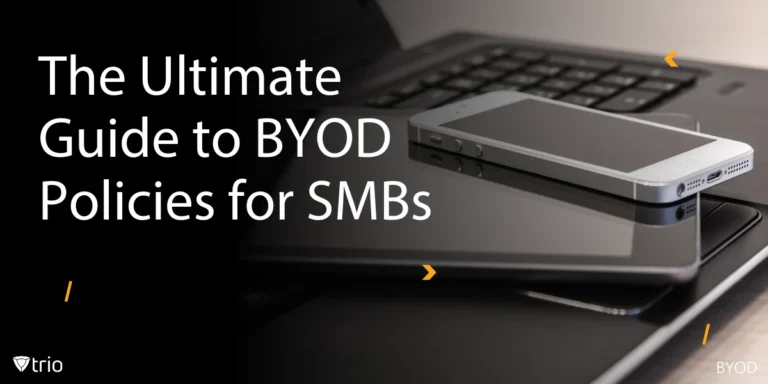Today's digital world demands a security model that leaves no stone unturned, which is where zero trust architecture comes into play. By adhering to the principle of "never trust, always verify," zero trust ensures that each network access request is thoroughly secured. This blog dives into zero trust architecture, its comparison with traditional security models, the essential principles, the strategic pillars supporting zero trust, and practical insights for its implementation. Plus, we discuss the benefits and challenges of transitioning to zero trust and how to choose the right platform.
What is Zero Trust Architecture?
According to this insight, zero trust architecture is a cybersecurity strategy that operates on a simple yet powerful principle: "Never trust, always verify." Unlike traditional security models that only focus on defending the perimeter, zero trust assumes that threats can come from anywhere, both outside and within the network. This approach treats every access request to the network as a potential threat, requiring verification regardless of where it originates. It's about making sure that only the right people, with the right level of access, can get to your valuable data, and they're checked every single time.
At the heart of the zero trust strategy is the belief that organizations are already under attack or could be at any moment. This mindset shifts how security measures are applied, ensuring that each request to access the network is explored and authenticated. By adopting zero trust, companies set up a dynamic and flexible defense that adjusts as new threats arise and as the organization's needs change. This makes the network more resilient to attacks because it minimizes the chances of intruders slipping through unnoticed. Essentially, zero trust is about protecting your digital assets by assuming the network is always at risk and acting accordingly.
The Evolution from Traditional Security to Zero Trust Architecture
The shift from traditional network security architecture to zero trust architecture marks a significant evolution in how organizations protect their digital assets. Traditional security models operate on the assumption that everything inside an organization's network can be trusted, focusing on protecting the perimeter from outside threats. This "trust but verify" approach has become less effective as cyber threats have grown more sophisticated and internal breaches more common. In contrast, zero trust architecture operates on a "never trust, always verify" principle, treating every access request as if it originates from an untrusted network. This prospective requires rigorous verification of every user and device trying to access resources, regardless of their location relative to the network perimeter.
Zero trust security architecture introduces a more adaptive and dynamic method for securing an organization's digital benefits. By requiring continuous verification of credentials and employing least-privilege access, it minimizes the attack surface and reduces the chances of unauthorized access. Zero trust network architecture enhances the security of data and applications and allows organizations to be more flexible, enabling secure access for remote workers and third-party collaborators. Zero trust principles apply uniformly across all users and devices, ensuring consistent security measures are in place. Furthermore, it plays a crucial role in preventing DDoS attacks by segmenting network access and rigorously validating traffic. Moreover, Adopting Zero trust principles secures networks against sophisticated cyber threats such as smishing attacks. Therefore, it provides a robust framework that can quickly adapt to new threats and changes within the IT environment.

Core Principles of Zero Trust Architecture
Zero trust Architecture definition revolves around a simple but powerful principle: trust no one, verify everyone. This approach shifts the security focus from traditional perimeter-based defenses to a more comprehensive model that treats every access request as if it originates from an untrusted network. The motto "never trust, always verify" builds this mindset, forcing organizations to authenticate and authorize every user and device before granting access to resources, regardless of their location inside or outside the organization's network.
The core of zero trust architecture is built on three main concepts:
- Verify Explicitly: Every access request, whether from a person or a device, must be rigorously authenticated, authorized, and continuously validated for security configuration and posture before being allowed access to resources.
- Use Least Privileged Access: This concept limits user access with just-enough-access (JEA) and just-in-time (JIT) principles, reducing the attack surface by providing users only the access they need to perform their tasks and nothing more.
- Assume Breach: Operating under the assumption that breaches can and will occur, this principle focuses on minimizing the impact of a breach by segmenting access, limiting lateral movement within the network, and enhancing monitoring for abnormal activity.
A solid zero trust architecture significantly contributes to IT risk management by proactively identifying and mitigating potential security threats before they can impact the network. It aligns with the principle of 'assume breach' and continuously validates every access request.
The Seven Pillars of Zero Trust Architecture
In the world of zero trust architecture, the framework is built upon seven fundamental pillars that ensure its effectiveness and reliability. These pillars serve as the guiding principles for setting up a secure network that doesn't just rely on traditional perimeter defenses.
- User Identity Verification: Every user accessing the system must be authenticated. This pillar emphasizes the importance of robust identity verification processes, such as multi-factor authentication (MFA), to ensure that access is granted only to verified users.
- Device Security: Ensures that all devices accessing the network are secure and compliant with the organization's security policies. This involves keeping the devices up to date with the latest security patches and using mobile device management (MDM) solutions to manage device security.
- Network Segmentation: This involves dividing the network into smaller, manageable segments. Segmentation helps in controlling access more efficiently and limiting the spread of threats within the network.
- Data Protection: Focuses on encrypting data both at rest and in transit. This pillar ensures that sensitive information is always protected, regardless of its location.
- Monitoring and Response: Continuous monitoring of network activities is essential. This allows for the quick detection of suspicious behavior and immediate response to potential threats.
- Security Policies: These are the rules and policies that govern how the network is accessed and used. The policies should be dynamic, adapting to changes in the threat landscape and the organization's needs.
- Least Privilege Access: Users and devices are given only the minimum level of access needed to perform their tasks. This principle reduces the risk of data breaches by limiting access to sensitive information.
Each of these pillars plays a critical role in the zero trust architecture, ensuring that every aspect of the network is secure. By adhering to these principles, organizations can create a more resilient and responsive security posture that is better equipped to handle the challenges of the modern digital world.

Advantages and Challenges of Zero Trust Architecture
Adopting a zero trust architecture brings several key benefits, all aimed at strengthening an organization's defense against cyber threats. At its heart, zero trust boosts the security posture by insisting on strict verification for every access request, regardless of origin. This "never trust, always verify" approach significantly minimizes the chances of unauthorized access, sharply reducing the risk of data breaches. Enhanced security posture isn't just about preventing unauthorized access; it's also about providing precise control over who has access to what within your network, ensuring that users and devices have only the necessary permissions, thus adhering to the principle of least privilege. Implementing zero trust architecture enhances vulnerability management practices by ensuring continuous scanning and patching of security vulnerabilities across all network access points. These benefits collectively lead to a more secure, resilient, and trustworthy IT environment.
However, moving to a zero trust architecture isn't without its hurdles. The transition can be complex, requiring a detailed understanding of the organization's current network and security setups. Implementing zero trust often involves overhauling existing security policies and infrastructure, which can be both time-consuming and costly. Furthermore, the complexity of setting up a zero trust architecture might require additional training for IT staff, adding to the implementation challenges. These hurdles, while significant, are not impossible. With careful planning, clear strategy, and the right tools, organizations can navigate these challenges and reap the substantial security benefits that zero trust architecture offers. A notable zero trust architecture example can be seen in the case of a financial services firm that rebuilt its network security by implementing a zero trust model. This approach involved deploying zero trust software solutions across its digital environment, resulting in a significant reduction in data breach incidents and unauthorized access attempts.
Who Needs Zero Trust? Identifying the Ideal Candidates for Implementation
Zero trust architecture isn't just a trend; it's a vital security framework that suits a wide range of organizations and sectors. Whether you're running a small startup or steering a large enterprise, the principles of zero trust can significantly uplift your cybersecurity stance. This approach is especially beneficial for sectors handling sensitive data, like financial services, healthcare, and government agencies, where the stakes for data breaches are incredibly high. These sectors can leverage zero trust to safeguard against sophisticated cyber threats, ensuring that only authenticated and authorized users access critical systems and data.
However, the appeal of zero trust architecture extends far beyond these high-stakes sectors. In today's digital-first world, even small businesses are not immune to cyber threats. Zero trust's universal applicability means it's just as crucial for these smaller entities, providing a scalable and flexible approach to security that grows with the business. The beauty of zero trust lies in its adaptability—regardless of an organization's size, industry, or the nature of its data. Implementing zero trust principles can significantly enhance its defense mechanisms against an ever-evolving landscape of cyber threats. This inclusive approach ensures that every organization can achieve a robust security posture. This makes zero trust architecture a wise choice for any entity that values the integrity and protection of its digital resources.

Choosing the Right Zero Trust Platform: What to Look For?
When picking the right zero trust platform for your organization, it's crucial to focus on features that match the core principles of zero trust architecture. The platform should offer robust identity verification, enforce least-privileged access, and enable micro-segmentation to manage and monitor traffic within your network securely. Here are key aspects to consider:
- Identity Verification and Access Control: Choose a platform that provides strong identity and access management (IAM). It should support multifactor authentication (MFA) and dynamic policy-making based on user, device, and application context. This ensures that only authenticated and authorized users and devices can access your network and resources.
- Micro-Segmentation Capabilities: Look for platforms that offer micro-segmentation, allowing you to divide your network into secure zones. This feature helps in controlling access to sensitive data and systems, limiting the potential impact of breaches. Effective micro-segmentation supports granular enforcement of security policies, making it harder for attackers to move laterally across your network.
- Visibility and Analytics: A capable zero trust platform should provide comprehensive visibility into your network traffic and real-time analytics. This allows for the detection of suspicious activities and potential threats, enabling quick response and remediation actions. Visibility across all network and cloud environments is essential for maintaining an effective zero-trust posture.
Furthermore, when evaluating zero trust platforms, it's essential to consider the role of zero trust software. This software forms the backbone of the zero trust model, offering features that are crucial for enforcing the 'never trust, always verify' principle.
Conclusion
In this digital era, using zero trust architecture emerges as a crucial step to achieve enhanced network security. This approach's detailed verification processes and its emphasis on least privilege ensure that your organization's data remains protected against the ever-evolving cyber threats. The integration of Mobile Device Management (MDM) with zero trust principles further boosts your security posture by ensuring comprehensive oversight and control over every device within your network.
Enter Trio, a comprehensive solution that aligns perfectly with zero trust architecture. By offering robust MDM capabilities, Trio supports the zero trust principle of "never trust, always verify", and enhances your organization's security framework. Trio's intuitive platform simplifies the management of mobile devices, enforcing strict access controls and ensuring that only authenticated and authorized users can access your sensitive data and applications. Discover the power of Trio and take the first step towards a secure future using its free demo.
Get Ahead of the Curve
Every organization today needs a solution to automate time-consuming tasks and strengthen security.
Without the right tools, manual processes drain resources and leave gaps in protection. Trio MDM is designed to solve this problem, automating key tasks, boosting security, and ensuring compliance with ease.
Don't let inefficiencies hold you back. Learn how Trio MDM can revolutionize your IT operations or request a free trial today!





